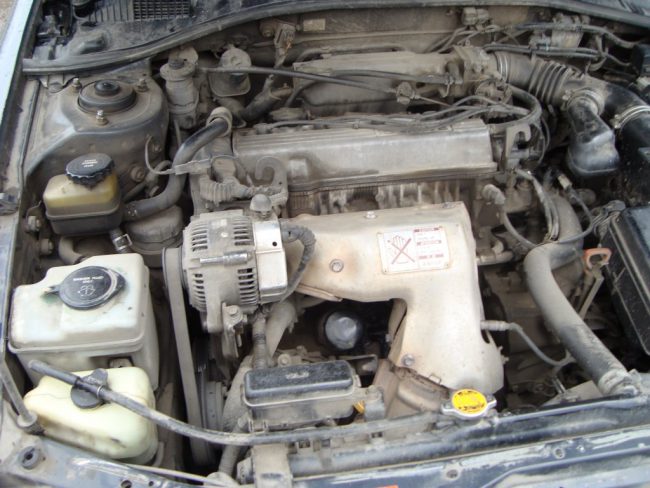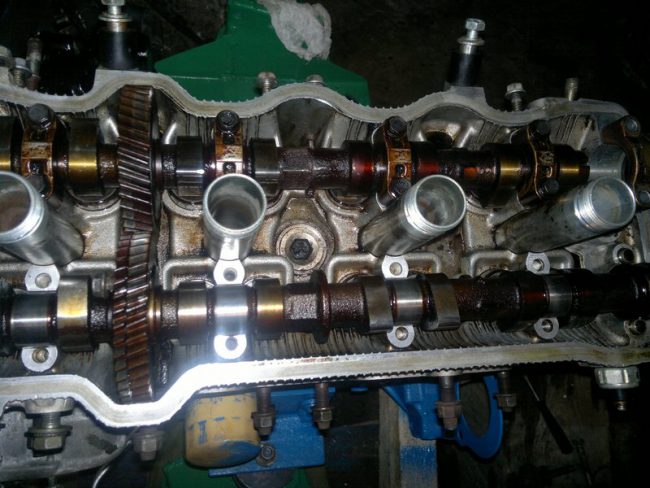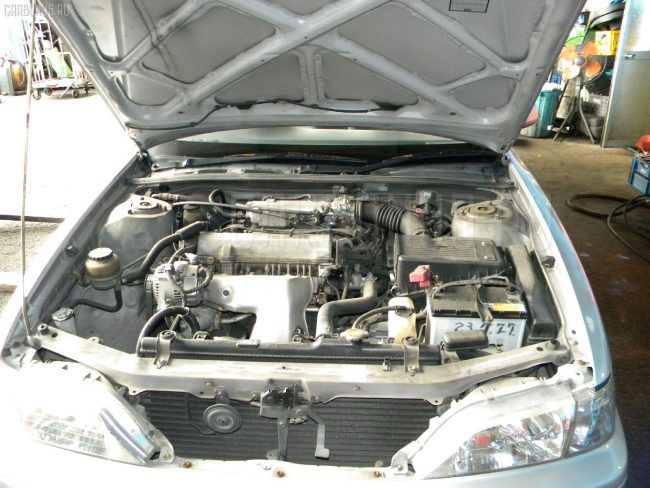
Toyota 4S-FE engine
Content
Japanese-made engines are considered to be among the most reliable, powerful and enduring in the world. Below we will get acquainted with one of the representatives - the 4S-FE engine manufactured by Toyota. The engine was produced from 1990 to 1999, and during this period it was equipped with various models of the Japanese brand.
Brief introduction
In the 90s, this engine model was considered the "golden mean" of the S series of engines, then produced by the largest Japanese automaker. The engine did not differ in economy, efficiency and high resource, but at the same time it had an advantageous side - maintainability.

The engine was equipped with ten models of cars manufactured by a Japanese company. Also, the power unit was used in restyled versions of classes D, D + and E. Another positive characteristic of the unit is that when the timing belt breaks, the piston does not bend the valve, which was made possible due to counterboring on the surface from the end.
In the model, it is worth noting the presence of MPFI - an electronic multipoint fuel injection system. Factory settings specifically underestimated the power of the internal combustion engine for the European market to 120 hp. With. If we talk about torque, then it fell to the level of 157 Nm.
First, the leading engineers of the manufacturing plant decided to use smaller volumes of combustion chambers in the engine when compared with the previous version of the unit. Instead of 2,0 liters, a volume of 1,8 liters was used. Mentioning the characteristics of the motor, it is worth noting the simplified scheme of the engine of an in-line gasoline atmospheric “four”. The unit is equipped with 16 valves, as well as a pair of DOHC camshafts.
The drive of one timing camshaft has a belt design. Attachments are mostly completed from the side of the front passenger seat. Forcing is represented by chip tuning. It is possible to overhaul with your own efforts, as well as upgrading the engine in order to increase power.
Technical specifications
| Manufacturer | Kamigo Plant Toyota |
| Weight, kg | 160 |
| ICE brand | 4SFE |
| Years of production | 1990-1999 |
| Power kW (hp) | 92 (125) |
| Volume, see cube. (l) | 1838 (1,8) |
| Torque, Nm | 162 (at 4 rpm) |
| Motor type | Inline petrol |
| Type of food | Injector |
| Ignition | DIS-2 |
| Compression ratio | 9,5 |
| Number of cylinders | 4 |
| Location of the first cylinder | TBE |
| Number of valves per cylinder | 4 |
| Camshaft | cast, 2 pcs. |
| Cylinder block material | Cast iron |
| Pistons | Original with counterbores |
| Intake manifold | Cast duralumin |
| An exhaust manifold | cast iron |
| Cylinder head material | Aluminium alloy |
| fuel type | Gasoline AI-95 |
| The piston stroke, mm | 86 |
| Fuel consumption, l/km | 5,2 (highway), 6,7 (combined), 8,2 (city) |
| Environmental standards | Euro-4 |
| water pump | Just Drive JD |
| The oil filter | Sakura C1139, VIC C-110 |
| Compression, bar | От 13 |
| Flywheel | Mounting on 8 bolts |
| Valve stem seals | Gods |
| Air filter | SA-161 Shinko, 17801-74020 Toyota |
| Candle gap, mm | 1,1 |
| Turnovers XX | 750-800 min-1 |
| Cooling system | Forced, antifreeze |
| Coolant volume, l | 5,9 |
| Adjustment of valves | Nuts, washers over pushers |
| Working temperature | 95° |
| Engine oil volume, l | 3,3 on Mark II, Cresta, Chaser, 3,9 on all other cars of the brand |
| Oil by viscosity | 5W30, 10W40, 10W30 |
| Oil consumption l/1000 km | 0,6-1,0 |
| Tightening force of threaded connections | Spark plug -35 Nm, connecting rods - 25 Nm + 90 °, crankshaft pulley - 108 Nm, crankshaft cover - 44 Nm, cylinder head - 2 stages 49 Nm |
The table above lists the fuels and lubricants recommended by the manufacturer.
Design features of the motor
The engine of the model in question is ready to boast a number of features that you should be familiar with. Here are the main features of the motor:
- Availability of MPFi system for single point injection
- The cooling jacket is produced inside the block when it is cast
- 4 cylinders are machined in the cast iron body of the block, while the surface is hardened by honing
- The distribution of the fuel mixture is carried out by two camshafts according to the DOHC scheme
- The use of engine oil viscosity 5W30 and 10W30 is recommended
- The presence of high pressure fuel pump to increase the compression ratio
- Availability of MPFi system for multi-point injection
- Ignition system DIS-2 without spark distribution

The key features don't stop there. You can find out more on the thematic forums.
Advantages and disadvantages
Like any technical tool, the 4S-FE engine has advantages and disadvantages. It’s worth starting with the pluses of the motor:
- No complex mechanisms
- Impressive operational potential reaching 300 kilometers
- Pistons won't bend valves when timing belt breaks
- Excellent serviceability with three piston oversizes and cylinder bore capability
The barrel of honey is not without tar, so you should also get acquainted with the shortcomings. Frequent adjustment of thermal valve clearances is a definite disadvantage of the motor of this model. This is due to the lack of phase control systems. The original solution of the company's developers simplifies the design on the one hand, since a pair of coils supplies a spark to 2 cylinders; there is an idle spark in the exhaust phase on the other side.
It is also worth noting the increasing load on the candles, due to which the operational resource is reduced. The specialists of the Japanese brand used a high-pressure pump in the engine, which often causes floating revolutions, as well as an increase in the oil level, and this is undoubtedly a minus.
What cars are equipped with an engine?
As mentioned above, the motor of this model was installed on a number of Japanese brand cars. We offer you a complete list of Toyota car models that were once equipped with a motor:
- Chaser midsize sedan
- Cresta Business Sedan
- Five-door station wagon Caldina
- Vista Compact Sedan
- Camry four-door business class sedan
- Corona midsize station wagon
- Mark II midsize sedan
- Celica sports hatchback, convertible and roadster
- Curren two-door coupe
- Left-hand drive export sedan Carina Exiv


Based on the above, the engine is widely popular due to its characteristics.
Regulatory requirements for motor maintenance
There are manufacturer-defined requirements, recommendations for servicing the power unit:
- Gates timing belt has a life of 150 miles
- The oil filter must be replaced along with the lubricant. The air filter is changed every year, while the fuel filter must be replaced after 40 kilometers (about 000 time in 1 years)
- Working fluids lose their properties after 10 - 40 thousand kilometers. After overcoming the mark, it is necessary to replace the engine oil, antifreeze
- Thermal valve clearances are subject to adjustment once every 1 - 20 thousand kilometers
- Candles in the system are operated 20 kilometers
- Crankcase ventilation is purged every 2 years
- The resource of the battery is determined by the manufacturer, as well as the operating conditions of the car
By adhering to the manufacturer's instructions, it is possible to operate the engine for the longest possible time.
Key malfunctions: causes and remedies
| Breakage type | Cause | Elimination path |
| Engine stalls or runs erratically | EGR valve failure | Exhaust recirculation valve replacement |
| Floating speed while increasing the oil level | Faulty injection pump | Repair or replacement of the high pressure fuel pump |
| Increased gas mileage | Clogged injectors / failure of the IAC / misalignment of valve clearances | Replacement of injectors / replacement of the idle speed regulator / adjustment of thermal gaps |
| XX turnover problems | Throttle valve clogged / fuel filter exhausted / fuel pump failure | Purge damper/replace filter/replace or repair pump |
| Vibrations | Deterioration of ICE cushions / rings in one cylinder | Cushion replacement/overhaul |
Engine tuning
If we are talking about an atmospheric engine of this model, which is intended for import into Europe, then it has underestimated characteristics. That is why, in order to restore the factory capacity of 125 hp. With. and torque at around 162 Nm, engine tuning is carried out. Mechanical tuning will cost much more, but it will allow you to get 200 hp. With. To do this, you need to purchase an intercooler for air cooling, mount a direct-flow exhaust and a "spider" instead of a standard exhaust manifold. You will also need to grind the intake tract channels, use a zero resistance filter. Be that as it may, in any case, tuning will cost a large amount, which is highly undesirable for the owner.

